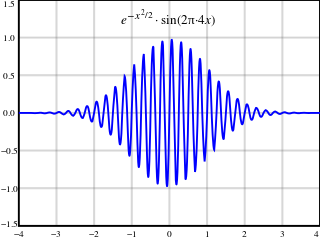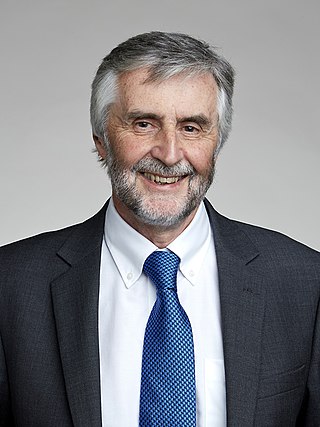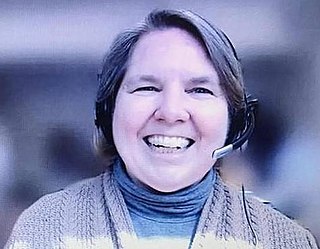SPIE is an international not-for-profit professional society for optics and photonics technology, founded in 1955. It organizes technical conferences, trade exhibitions, and continuing education programs for researchers and developers in the light-based fields of physics, including: optics, photonics, and imaging engineering. The society publishes peer-reviewed scientific journals, conference proceedings, monographs, tutorial texts, field guides, and reference volumes in print and online. SPIE is especially well-known for Photonics West, one of the laser and photonics industry's largest combined conferences and tradeshows which is held annually in San Francisco. SPIE also participates as partners in leading educational initiatives, and in 2020, for example, provided more than $5.8 million in support of optics education and outreach programs around the world.

A frequency comb or spectral comb is a spectrum made of discrete and regularly spaced spectral lines. In optics, a frequency comb can be generated by certain laser sources.

Chinese Optics Letters is a monthly peer-reviewed scientific journal published by Optica. Established in 2003, it covers optics research originating in the People's Republic of China as well as coverage from groups outside the country.

The University of Arizona College of Optical Sciences, considered the largest institute for optics education in the United States, is dedicated to research and education in optics with an emphasis on optical engineering. The college offers more than 90 courses in optical sciences, and a Bachelor of Science degree in Optical Sciences and Engineering, Masters and Doctoral degree programs in Optical Sciences, as well as a dual master's degree in Optical Sciences and Business Administration. The college also offers comprehensive distance learning courses leading to a Professional Graduate Certificate or a master's degree and markets non-credit short courses on DVD to optics professionals.

An atomic clock is a clock that measures time by monitoring the resonant frequency of atoms. It is based on atoms having different energy levels. Electron states in an atom are associated with different energy levels, and in transitions between such states they interact with a very specific frequency of electromagnetic radiation. This phenomenon serves as the basis for the International System of Units' (SI) definition of a second:
The second, symbol s, is the SI unit of time. It is defined by taking the fixed numerical value of the caesium frequency, , the unperturbed ground-state hyperfine transition frequency of the caesium-133 atom, to be 9192631770 when expressed in the unit Hz, which is equal to s−1.
A quantum clock is a type of atomic clock with laser cooled single ions confined together in an electromagnetic ion trap. Developed in 2010 by physicists at the U.S. National Institute of Standards and Technology, the clock was 37 times more precise than the then-existing international standard. The quantum logic clock is based on an aluminium spectroscopy ion with a logic atom.
John Michael Dudley is a physicist and currently Professor of Physics at the University Bourgogne Franche-Comté working at the joint University-CNRS research Institute FEMTO-ST in Besançon, France. Originally from New Zealand, he is known for his research in nonlinear and ultrafast optical physics, for service to international scientific societies, and for initiatives in promoting international scientific outreach and the public communication of science.

Jun Ye is a Chinese-American physicist at JILA, National Institute of Standards and Technology, and the University of Colorado Boulder, working primarily in the field of atomic, molecular, and optical physics.

Patrick Gill is a Senior NPL Fellow in Time & Frequency at the National Physical Laboratory (NPL) in the UK.
James G. Fujimoto is Elihu Thomson Professor of Electrical Engineering and Computer Science at the Massachusetts Institute of Technology (MIT) and a visiting professor of ophthalmology at Tufts University School of Medicine, Boston, Massachusetts.

Mona Jarrahi is an Iranian Engineering professor at the University of California, Los Angeles. She investigates novel materials, terahertz/millimeter-wave electronics and optoelectronics, microwave photonics, imaging and spectroscopy systems.

Carmiña Londoño emeritus Deputy Division Director of the Electrical Communications and Cybersystems Division at the National Science Foundation. She previously spent 13 years at the National Institute of Standards and Technology, where she led the Global Standards and Information Group. Dr. Londoño spent two terms on the Board of Directors of SPIE, and the SPIE's Director's Award in 2019.
Christina C. C. Willis is an American laser scientist who works in optics and high-power laser development. She is involved with policy, outreach and volunteering. Willis is a board member of SPIE, the international society of optics and photonics. As of January 2019, she completed an 18-month expedition around the world. She is serving as an Arthur H. Guenther Congressional Fellowship from 2019 to 2020. In January 2020, she published the book Sustainable Networking for Scientists and Engineers, which addresses networking in a holistic sense, encouraging readers to treat professional support as a resource that is sustained by contributing more than you can take.
Shouleh Nikzad is an Iranian-American electronic engineer and research scientist at the Jet Propulsion Laboratory. She leads the Advanced Detector Arrays, Systems, and Nanoscience Group. Her research considers ultraviolet and low-energy particle detectors, nanostructure devices and novel spectrometers. Nikzad is a Fellow of the American Physical Society, the National Academy of Inventors and SPIE.
Carmen S. Menoni is an Argentine-American physicist who is the University Distinguished Professor at Colorado State University. Her research considers oxide materials for interference coatings and spectrometry imaging. She is a Fellow of the Institute of Electrical and Electronics Engineers, American Physical Society, Optica, and SPIE. Menoni served as the President of the IEEE Photonics Society from 2020 to 2021.

Jürgen W. Czarske is a German electrical engineer and a measurement system technician. He is the director of the TU Dresden Biomedical Computational Laser Systems competence center and a co-opted professor of physics.

Marla Lorraine Dowell is an American physicist who is Director of the CHIPS R&D Metrology Program and NIST Boulder Laboratory.
Pascal Del'Haye is a German physicist specializing in integrated photonics. He is heading the Microphotonics Research Group at the Max Planck Institute for the Science of Light.
Kristan Lee Corwin is an American physicist who is a professor and division chief at the National Institute of Standards and Technology. Her research considers nonlinear optics and emerging laser systems.
Vassilia Zorba is a Greek-American plasma physicist, group leader and professor at Berkeley Lab. Her research focuses on the development of ultrafast laser plasma spectroscopies. She specialises in femtosecond laser-matter interactions. She is a Fellow of the Royal Society of Chemistry and Optica.










